Review: 'Decision at Doona', 'Crisis on Doona', 'Treaty Planet' and 'Doona', by Anne McCaffrey and Jody Lynn Nye
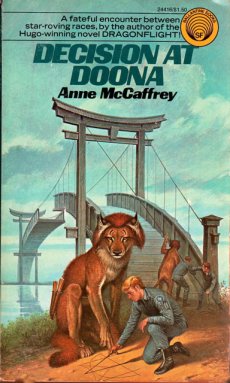 Decision at Doona by Anne McCaffrey (1926-2011) is one of the classics of science fiction, and one of the most encouraging examples of the basic plot of humans and Furry aliens learning to live and work together in harmony. Published in 1969, it was one of the favorite novels of the proto-Furry fans within s-f fandom in the 1970s and the earliest Furry fans in the 1980s.
Decision at Doona by Anne McCaffrey (1926-2011) is one of the classics of science fiction, and one of the most encouraging examples of the basic plot of humans and Furry aliens learning to live and work together in harmony. Published in 1969, it was one of the favorite novels of the proto-Furry fans within s-f fandom in the 1970s and the earliest Furry fans in the 1980s.
In the far future, two civilizations are unaware of each other; humanity and the felinoid Hrrubans. Both face catastrophic overpopulation which is leading to exhaustion of natural resources and food, a sharply increasing suicide rate, an increase in public apathy resulting in a dramatic decrease in training for technical or administrative positions, and so on. Government officials fear a complete collapse of civilization in just a few more generations.
Both species are searching for new planets to colonize, but they have had traumatic experiences with alien cultures in the past. The humans are governed by the Principle of Non-Cohabitation that resulted from:
...the terrible Siwannah tragedy […] And never, since the mass suicide of the gentle Siwannese, had a colony been set up where another intelligent species had been discovered by Spacedep. (p. 20)
The human protagonist is Ken Reeve, who has been looking forward impatiently for years to emigrate from overcrowded Earth to a wide-open colony planet.
Home! [Earth, the leader of the Amalgamated Worlds.] A planet so overpopulated you married at sixteen to get on the list to have one of the two children allowed you before you were thirty – that is, if you could prove that you had no hereditary genetic faults or handicapping recessive traits. A planet so crowded for space there were only twelve Square Miles of international backyard remaining. He’d been eighteen before he had touched dirt, seen grass or smelled a pine tree. A trip to the local Square Mile had been his cherished award for being top man in Section Academy. The poignant memory of the experience had motivated and sustained him during the frustrating years of intensive study necessary to qualify for immigration under Colonial Department jurisdiction. (pgs. 17-18)
Ken is overjoyed when he is approved to become a colonist with his family on the newly approved (which automatically means uninhabited) idyllic world of Doona. Setting up the colony means a long spaceship journey from Earth, arriving just as the Doonan winter is starting, and spending eighteen months clearing land to construct their frontier town. It is hard work, but Ken and ten other male colonists including colony leader Hu Shih, Sam Gaynor, Ezra Moody, and Vic Solinari work happily and enthusiastically to build their new home and prepare for their families. Winter turns to spring, and the colonists have just finished their town and are waiting for the spaceship bringing their families and farm animals when Ken and Sam return from exploring with unbelievable news:
An hour later, when Ken and Sam returned at a dead run and in a kind of incredulous wrath, they had to hang on the air whistle for five minutes before anyone returned.
‘What’n’hell’s the matter with you, Reeve?’ demanded Lee Lawrence, the first to arrive.
‘We’re not alone on Doona, Lee,’ Ken cried, waving the quick-prints at the startled sociologist. ‘We’re not alone!’
‘You’re round the bend, man!’
‘No, he’s not,’ growled Sam Gaynor, his face set in hard, bitter lines. ‘There’s a village across the river in that grove of porous wood trees, where the river widens below the falls. A big village, full of furred, tailed cats that walk on their hind legs and carry knives.’ (p. 14)
The Hrrubans are described in greater detail later:
Close up, the resemblance to cats was uncanny, Reeve thought, returning the solemn stares solemnly.
The great green eyes regarded him from under straight wide brows, dark pupils narrowed against the orange sun. Flattish noses were broad at the nostril over lipless wide mouths. The chins were short bridges in the middle of the wide hinged jaw. The lobeless ears had tufted tips. Each child -- for their very appearance and attitude cried youth to Reeve – wore a belt around his middle. A short sheathed knife hung from it without covering their obvious maleness. Their skins were a light fawn, like a soft velour, but their heads were covered with a darker tan mop of hair that hung to their ear tips. Visible between their spraddled legs were short, tufted tails, stuck straight out behind them in surprise. (p. 29)
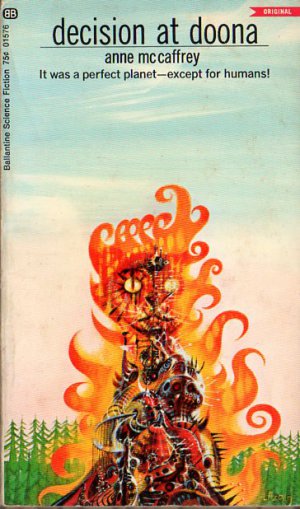 There is general consternation. Nobody knows how the government’s exploration team could have missed the felinoid natives, but their existence is undeniable. And by the Principle of Non-Cohabitation, this means that the humans have to give up their colony and return to Earth. Everyone is bitter but resigned, but the spaceship with their families and livestock arrives before the Earth government can be informed, and the humans and felinoids meet. The natives are friendly, as they say; possibly too friendly, showing no culture shock, teaching the humans their language (the Hrruban name for Doona is Rrala), and constructing an impressive bridge to link their two villages. None of the women want to return to overcrowded Earth, either. Why can’t they stay despite the Principle of Non-Cohabitation, since the Hrrubans are clearly not traumatized by the humans into committing mass suicide?
There is general consternation. Nobody knows how the government’s exploration team could have missed the felinoid natives, but their existence is undeniable. And by the Principle of Non-Cohabitation, this means that the humans have to give up their colony and return to Earth. Everyone is bitter but resigned, but the spaceship with their families and livestock arrives before the Earth government can be informed, and the humans and felinoids meet. The natives are friendly, as they say; possibly too friendly, showing no culture shock, teaching the humans their language (the Hrruban name for Doona is Rrala), and constructing an impressive bridge to link their two villages. None of the women want to return to overcrowded Earth, either. Why can’t they stay despite the Principle of Non-Cohabitation, since the Hrrubans are clearly not traumatized by the humans into committing mass suicide?
The reader knows that the Hrrubans are not natives of the planet, but the mysteries remain of where they had been until they appeared with their villages all set up, where their settlements on Doona other than nearby small villages are, and what their real plans for the humans are? (There are occasional chapters on the Hrruban home planet showing their own conservatives demanding that they leave Doona because of their equivalent of the Principle of Non-Cohabitation, and their First Speaker arguing that they cannot pass up this opportunity to establish peaceful relations with another starfaring species on a neutral planet.) Ken does not want to turn down their too-good-to-be-true friendship, but he cannot bring himself to fully trust it, either, especially since all the Hrrubans politely change the subject when asked for more information about their culture. Faster-than-light homing capsules from Earth bring contradictory panicked officious orders from the three bureaucracies involved; Alreldep (Alien Relations Department), Codep (Colonial Department), and Spacedep (Space Department).
The humans and the Hrrubans form individual friendships – Ken with Hrrula, an important member of the nearest Hrruban village -- and closer social relations. Ken’s six-year-old son Todd charms the Hrrubans by making himself a rope tail like theirs and following them around everywhere. Todd and a Hrruban boy, Hrriss, form an inseparable friendship. Todd becomes practically an adoptive Hrruban, “going native” more fully than any of the humans.
The mystery suddenly intensifies sharply when Commander Al Landreau of Spacedep arrives from Earth to see the “impossible” Hrrubans, and the colonists find that they – and their villages – have completely disappeared. Landreau finally leaves, believing that the Hrrubans are a hoax, and the colonists are forced to admit that the Hrrubans must be technologically advanced aliens of some kind, since genuine primitive natives could not have disappeared so fast or so thoroughly. Todd is heartbroken at the disappearance of Hrriss.
The Hrrubans instantly reappear (so do giant reptiloid predators) as soon as the Spacedep officer blasts off, tacitly admitting that they are spacefaring aliens but saying nothing except that they are under orders to say no more. The colonists, now under Ken’s unofficial leadership, decide that, even without evidence, they trust the Hrrubans more than the Earth government. There is a tense confrontation between the three Earth bureaucracies, the Hrruban liberal and xenophobic factions among their executive leadership, and the human and Hrruban governments, in which the colonists must try to be more than helpless pawns. Thanks to Ken and the headstrong Todd, all ends happily.
That is not really a spoiler since the existence of the two sequels gives away that all ends well. As a side note, McCaffrey’s son is named Todd and he was a child when she wrote this novel. Today he is a major s-f author in his own right.
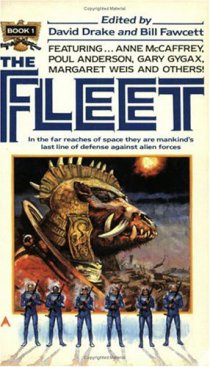
Fans wanted more Doona. They almost missed it when McCaffrey wrote a novelette almost twenty years later, “Duty Calls”, published in the original-fiction anthology The Fleet, edited by David Drake and Bill Fawcett (Ace Books, May 1988). The Fleet was an anthology of military-action s-f, and “Duty Calls” features a Hrruban, Senior Lieutenant B'ghra Hrrunalkharr (“call me Ghra”), serving with a team of human space commandos in an interstellar war. This is set several hundred years after Decision at Doona, when the humans and Hrrubans are fully integrated into a joint society and fighting the Khalia.
“Duty Calls” was minor, but it led to a full-length novel four years later. Crisis on Doona was written by McCaffrey in collaboration with Jody Lynn Nye (1957- ), but it was copyrighted by Bill Fawcett & Associates, McCaffrey’s co-editor of The Fleet. Fawcett was the editor or packager of several other s-f books featuring anthropomorphized felinoids (the four Guardians of the Three novels, two of the three Shattered Light novels, the anthology Cats in Space and Other Places), so possibly he should get more credit for the two Doona sequels.
Crisis on Doona and Treaty at Doona are both a bit more simplistic. Where Decision at Doona does rely on conflict between the free-thinking Doonan colonists and a reactionary bureaucracy spearheaded by a corrupt military officer, Crisis and Treaty are more shallow “civilian individuals = good vs. officious military bureaucrats = bad” dramas. The antagonists are not just xenophobic; they are exaggeratedly paranoid.
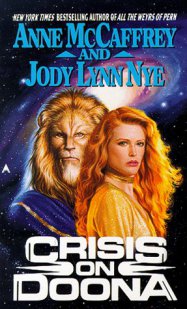 Crisis on Doona is set twenty-five years after the first novel. The crisis is that the Treaty establishing Doona’s joint occupancy is expiring. The past twenty-five years have been a big success for Human-Hrruban friendship, but powerful xenophobic forces among both Human and Hrruban bureaucrats are working against its renewal. This would force the Human colonists to leave Doona.
Crisis on Doona is set twenty-five years after the first novel. The crisis is that the Treaty establishing Doona’s joint occupancy is expiring. The past twenty-five years have been a big success for Human-Hrruban friendship, but powerful xenophobic forces among both Human and Hrruban bureaucrats are working against its renewal. This would force the Human colonists to leave Doona.
The original twenty-five years of that Decision were nearly over and renegotiation soon to be discussed. Both Todd and Hrriss knew of the recent incidents which they were certain had been arranged with the express aim of creating dissention between Hrruban and Human, rupturing the Treaty, and, more important, preventing a renewal of the unique settlement on Doona/Rrala. (p. 8)
During these twenty-five years, the population of Doona has increased to over 100,000, and space exploration in the astronomical neighborhood of Doona has blossomed. Todd Reeve and Hrriss have become teammates in the space scout Albatross for the Alien Relations Department. It is no secret among either Humans or Hrrubans that Al Landreau, now the Admiral in charge of Spacedep, is the leader of the Human supremacy movement. His motivation for sabotaging the Decision, aside from revenge against the Reeves and the Hrrubans, is that it would render the clauses void granting an equal percentage of newly-discovered planets to the Hrrubans, leaving them open to poaching by Spacedep. Unfortunately, the blatancy of this is also used by the xenophobes among the Hrrubans as proof that the Humans cannot be trusted.
The “recent incidents” become personal when Todd and Hrriss are framed for taking advantage of their space scout duties to smuggle valuables and illicit goods between planets, and to rustle Doonan horses to build a private fortune. Since they are the “poster boys” for the success of the Doonan experiment, the appearance of their dishonesty is an obvious attack on the Treaty.
Nobody on Doona believes in their guilt, and while Todd and Hriss languish under house arrest while awaiting their trial, their family and friends investigate to prove their innocence. Todd’s tomboyish friend Kelly Solinari, who has romantic feelings for him, and Hrriss’ intended lifemate Nrrna have separate adventures spying on the powerful bureaucrats among Humans and Hrrubans who oppose the Treaty. (Crisis on Doona’s cover by Michael Herring features Hrriss and Kelly, misleadingly implying an interspecies romance between the two.) It is found that the conspiracy is well-planned and long-standing. Todd’s and Hrriss’ innocence of some of the charges is proven, but the Treaty opponents ram through a resolution that all the charges must be disproven before the Treaty can be renewed, and there may not be time for this. Then Ken and Todd Reeve disappear, to the consternation of the Doonans and villains alike.
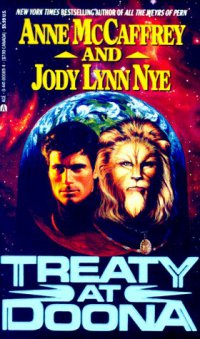
Treaty at Doona, also by McCaffrey & Nye and copyrighted by Bill Fawcett & Associates, followed two years later. The British edition, titled Treaty Planet (with a cover by Mark Harrison), was published in hardcovers seven months earlier. Treaty is set only nine years after the events in Crisis, but much has changed. The planet is now called Doonarrala, or Rraladoon depending upon whether the speaker is Human or Hrruban. The majority attitude since the Treaty’s renewal has shifted from keeping Doona as a pastoral paradise to favoring a rapid commercial development. A referendum to construct a free trade and spaceport facility on the Treaty Island subcontinent has just passed by a slim majority. For the first time Todd and Hrriss are divided on an issue; Todd and his father are against the commercialization of Doona, while Hrriss and most Hrrubans favor it. The expected increase in Doona’s space economy has brought Spacedep’s new Admiral, Everett Barnstable, who wants to establish a visible presence at Doona’s new spaceport.
The novel begins at a conference at the site of the spaceport on Treaty Island. Political maneuvering has barely begun on several basic issues – will the spaceport be administered by Humans, Hrrubans, or both; should the Hrrubans share their matter transmitter grid technology for it; should the spaceport be on a space station above the planet instead of on the surface – when a massive spaceship of an unknown species arrives above Doona. The Gringg look vaguely like huge bears:
The first of the aliens to enter, a bulky creature covered except for its face and the pads of its forepaws with thick, long fur of light honey-brown, stood just over two meters in height. Its face had a square muzzle with a black, leathery nose, black-fleshed lips, and two deep-set, eyes the color of red wine protected by thick, smooth-skinned eyelids fringed at the edges with more honey hair. Todd was amazed to see that its facial features were arranged in the same way as a Human’s or a Hrruban’s.
Its shoulders sloped from a thick neck toward a huge rib cage, and downward over a powerful lower body supported by very short but thick legs. It wore a pouch-laden belt and ornately decorated collar cut from a scaly hide of some kind. Todd thought it resembled snakeskin – but what a snake! If the size of the scales was any clue, it had been equivalent to a Great Big Momma Snake. The alien blinked at the visitors curiously before standing aside to make way for the two other aliens. The being behind it, identical in appearance but black-brown in color, was nearly two and a half meters tall. It too wore a collar, this one more elaborate than the first alien’s, consisting of woven strips punched and stamped with complex designs. […] (p. 45)
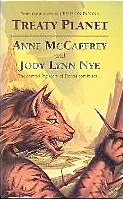 The first contact seems to be peaceful, but there are enough suspicious comments among the Gringgs’ conversation between themselves – “‘I, too, still worry that they do not trust us. It is vital that they see us as harmless. Let us continue to shield our reactions and walk among them to reassure the small ones.’” (p. 81) – to keep the reader wondering about their real intentions. Then, while the Doonans and the “peaceful” Gringgs are building a language base, the Spacedep officers discuss earlier evidence that the Gringgs are really extremely dangerous:
The first contact seems to be peaceful, but there are enough suspicious comments among the Gringgs’ conversation between themselves – “‘I, too, still worry that they do not trust us. It is vital that they see us as harmless. Let us continue to shield our reactions and walk among them to reassure the small ones.’” (p. 81) – to keep the reader wondering about their real intentions. Then, while the Doonans and the “peaceful” Gringgs are building a language base, the Spacedep officers discuss earlier evidence that the Gringgs are really extremely dangerous:
Everyone drew shocked breaths when the new tape showed an uncompromising picture of a planetary landscape brutally torn and burned by conflict. Wrecked hulks of buildings of an unfamiliar architecture had been sliced in two with some potent destructive weapon. Battered shafts that did resemble known weaponry littered broad open spaces that must once have been graceful avenues. Castleton peered at the screen, looking desperately for signs of living creatures. A series of scenes of stark, dead forests and the stumps of shattered cities flashed past without relief. Nothing living interrupted the bleak landscape. Of the residents, only a few skeletal remains could be found, and those were darkened and twisted: by radiation, the captain thought, somewhat familiar with the look of such deaths. Nothing moved except ashy debris swept around by the wind that howled eerily. The statistics overlaying the image showed readings of heavy radiation. The changing symbols also showed that biological and chemical weapons, and an unknown energy weapon of great force had been deployed. (p. 92)
The Spacedep officers agree that they should prepare secretly to counter a Gringg surprise attack, while leaving Todd and the Doonans uninformed to lull the Gringg into believing that their pose as peaceful aliens is successful:
‘Admiral,’ Castleton said, also rising, ‘shouldn’t we inform the planetary administration of our discovery?’
‘Indeed we should not, sir,’ Greene said suddenly. […] ‘I’d recommend against it. For security reasons alone. We certainly don’t want the grids jammed with people insisting that their department has to have representatives here, too. The necessary departments have already been informed and are present. No more information should be broadcast.’ And when eventually the Amalgamated Worlds knew, Greene thought with satisfaction, Todd Reeve would be disgraced, even removed from planetary office as a danger to Humanity. (p. 98)
Spacedep’s hostility to the Gringg is so obvious that Todd and his supporters instantly react against this outside interference, setting up a new Doonan vs. Spacedep+xenophobe conflict that pushes the Gringgs’ true motives into the background. Several of the more recognizable Gringg, notably Captain Grzzeearoghh (“Grizz”), become familiar figures on Doonarrala:
Gradually the daily sight of the large, shaggy strangers moving about with their Human or Hrruban escorts took the edge off the ‘fearsome hairy monsters’ appellation. The Gringg became the ‘big bears,’ or Bruins, to most Doonarralans. But xenophobic pessimists somehow began arriving from Terra and Hrruba, and familiarity was not going to appease them. They visited every village, Hayuman and Hrruban, whispering against the ‘fiendish Gringg’. They muttered about ‘murders most vile’ and ‘devastated worlds’, but would slip away before they could be closely questioned. (pgs. 150-151)
When the Human-Hrruban-Gringg translation voder is perfected, the Gringg give an open account of their origins and explain that they have come to establish friendly trade relations with Doonarrala. Everyone except the xenophobes is overjoyed, and the matter of the spaceport is reopened. The addition of the Gringgs means that an even larger spaceport is needed, as Todd is forced to agree with.
While the Humans and the Gringgs expand their friendly relations to the average Doonarralan citizens, the Spacedep contingent and their allies among the Hrruban xenophobes prepare to forestall the Gringg treachery that they are sure is planned:
Barnstable planted a firm finger on the tabletop. ‘Cunning, too. All that openness and charm … right up to the moment they’re ready to take over this planet!’
Such an emphatic pronouncement silenced the others.
‘Only a week, maybe less,’ Hrrrv said in a tone of some desperation, ‘and we’ll have a superior force in Rraladoonan skies. Zen we will ze authority’ – he paused and drew his lip back from his teeth – ‘zat will wring ze zruth from these ‘bears’!’
‘Reeve and Hrrestan can be removed as planetary leaders,’ Barnstable said, rubbing his hands together in anticipation, ‘as unfit to govern … since they’ve extended hospitality to so clearly a menacing species, endangering the citizens of both species.’ (p. 206)
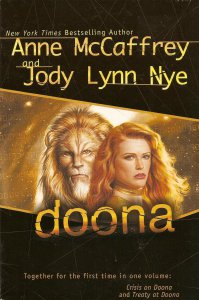 Despite the ominous buildup, and a climactic armed confrontation, there is such a happy ending that no reader could doubt that the Doona series was finished. Crisis on Doona and Treaty at Doona were collected into a single trade paperback edition, Doona, by Ace Books ten years later, but all are out of print today. Decision at Doona, which started it all, is still going strong; currently in its 28th printing at $6.99.
Despite the ominous buildup, and a climactic armed confrontation, there is such a happy ending that no reader could doubt that the Doona series was finished. Crisis on Doona and Treaty at Doona were collected into a single trade paperback edition, Doona, by Ace Books ten years later, but all are out of print today. Decision at Doona, which started it all, is still going strong; currently in its 28th printing at $6.99.
Although this is primarily a review of the three Doona novels, I would like to take this opportunity to say a few words about the cover art for Decision at Doona. The cover of the first printing is by Richard M. Powers (1921-1996). Powers was one of the most prominent s-f cover artists from the beginning of s-f books in the late 1940s through the 1960s. His “futuristic” Surrealist art supposedly visually defined “science fiction” during this period. He was a personal friend of Ian and Betty Ballantine, and painted the cover of Ballantine Books’ first s-f title, Pohl & Kornbluth’s The Space Merchants in 1953, and the covers of most of Ballantine’s s-f books of the 1950s and early 1960s. His cover for Decision at Doona in 1969 was one of the last of his s-f works. By the time of the novel’s second printing in April 1975, Powers’ abstract style had gone out of fashion and been replaced by the more realistic look represented by Darrell K. Sweet (1934-2011). Sweet’s 1975 cover for Decision at Doona has been the standard cover reprinted by Ballantine Books ever since. These two covers for Decision at Doona are excellent representatives of the two most popular styles of s-f art; the abstract and the representational.
Decision at Doona, by Anne McCaffrey.
NYC, Ballantine Books, April 1969, paperback #01576 75¢ ([ix] + 245 [+ 1] pages).
Crisis on Doona, by Anne McCaffrey and Jody Lynn Nye.
NYC, Ace Books, March 1992, paperback 0-441-23194-2 $4.99 (328 pages).
Treaty Planet, by Anne McCaffrey and Jody Lynn Nye.
London, Corgi Books, February 1994, hardcover 1-85723-139-2 £16.99 (441 pages).
Treaty at Doona, by Anne McCaffrey and Jody Lynn Nye.
NYC, Ace Books, September 1994, paperback 0-441-00089-4 $5.99 (342 pages).
Doona, by Anne McCaffrey and Jody Lynn Nye.
NYC, Ace Books, February 2004, trade paperback 0-441-01131-4 $15.00 (585 pages).
About the author
Fred Patten — read stories — contact (login required)a retired former librarian from North Hollywood, California, interested in general anthropomorphics
Comments
I submitted this review in May 2013, and I am delighted to see it in print at last! I could not claim that it was time-critical, so I could not object when more recent stories have been advanced ahead of it in the queue. But the Doona novels are still very enjoyable, and should not be forgotten or overlooked by Furry fans.
Fred Patten
Thank you for your review, Fred. I like to read these, shall we say, earlier, sci-fi and fantasy books, especially Ray Bradbury. I particularly enjoy thinking about how they are products of their time, sometimes reflecting values and views held by society at that time. I look at that first cover illustration, the one for Decision at Doona, with the man scribing figures in the sand, and I think "What? Did he forget his Ipad back at the ship?" :)
Science fiction is full of these. I have many favorite examples, such as "The Proud Robot" by Lewis Padgett (Henry Kuttner & his wife, Catherine Moore), October 1943. It's set in a far future of flying cars, intelligent robots, and so on, including abandoned giant movie theaters that have been rendered obsolete by the new invention of television. But the story is about trying to figure out the real purpose of a revolutionary new robot that considers itself vastly superior to mankind. It turns out to be a mobile can opener, for opening beer cans. Of course, hardly anyone has needed can openers since pop-top cans became common in the 1950s.
The first s-f review I ever wrote was of a Furry novel, "Little Fuzzy" by H. Beam Piper in 1962. It's still excellent, set in the far future on the interstellar planet Zarathustra. There are spaceships, hover cars, and so on. But reviews since about the 1980s have pointed out how it's getting more and more dated: people play large 33 1/3 l.p. records; men are executives and women are secretaries; there is advertising everywhere for cigarettes, etc.
A favorite horrible example is the novel "Lest Darkness Fall" by L. Sprague de Camp, published in 1940. There is nothing wrong with it, but it is obviously dated. It opens in modern Rome, full of images of Mussolini's fascist Italy, and prices when the Italian lira was worth a lot. But some publisher around 1960 decided to "update" it, and did a very bad job of it. The references to fascism were removed, but Mussolini was still left as the current Prime Minister; a contemporary of John Kennedy.
But I enjoy the late 19th century non-s-f novels of Horatio Alger, Jr. for the same reason. A hamburger is a "Hamburg-style beef patty". "Lunch" and "bus" are low-class slang; the proper-English terms are "luncheon" and "omnibus". A dime is nicknamed a "shilling", and his novels written before the 1880s never refer to "nickels" because the nickel 5¢ coin was only introduced in 1883. Before that, they were silver (and a coin half the size of a dime was always getting lost), and the slang term for a silver 5¢ coin was a "sixpence". Central Park in New York was brand-new, and a good wage was $10.00 a week -- most people only earned $1.00 a day; $7.00 a week. Illinois was "the West", as distinct from "the Far West" of the other side of the Rockies.
I have said before how I read the 1948 "Space Cadet" by Robert A. Heinlein when I was nine or ten. It is set in the late 21st century, when space travel inside the orbit of Jupiter is common. There is a scene toward the beginning where the teenage hero, outdoors, gets a call on his mobile phone. I was extremely impressed by the prediction that people would have personal mobile phones that they could carry with them everyplace by the end of the 2000's. Of course, they've been common since the 1990s.
And just about all s-f written before the 1950s predicted a habitable Venus and Mars, with Venus being a steamy jungle and Mars a dry but livable desert with desert-type life forms. Isaac Asimov spent a lot of time after the late 1950s apologizing for the astrologic errors in his early s-f stories, pointing out that they had been based on the best science when they were written.
Fred Patten
I had a little trouble with this sort of thing on a smaller scale in a story I finished a couple of years ago. The story was set in 2000 and I started writing it in 2003, when most of the technology was still current, but progress on the story was slow for several years until I got my butt in gear and finished up the last several chapters in 2011. By that time I was having to remind myself of things such as that in 2000 most people didn't carry cellphones, and home video usually meant VHS cassettes, with DVDs just starting to make their first appearance.
Light on Shattered Water (review) has as one of its plot elements a laptop computer that the main character had with him when he was transported into an alternate reality. Although the author, Greg Howell, made some surprisingly good guesses when the story was originally written in 1995-1998, he made several revisions to bring it in line with current technology when it was released as an e-book in 2012.
An excellent and hilarious example is Murray Leinster's "A Logic Named Joe", published in early 1946 (probably written in 1945), which practically nails personal computers and the Internet to a T, including the kids using their parents' unsecured computers to watch adult pornography. Except that Leinster predicted that they would be called logics instead of home computers.
I lived through the VHS-Betamax wars of the 1980s. Today I see predictions that both the DVD and the Blu-Ray will probably become extinct in the next decade.
Fred Patten
When I read this series several years ago, I remember thinking Decision at Doona and Crisis on Doona were among the better books I had read. At the time I thought Crisis on Doona was the best of the series, but if I were to reread them now I would probably see its flaws more and would instead favor Decision at Doona. Treaty at Doona was noticeably inferior. Some of the plot threads that had been started were never adequately played out, and the snake hunts were getting repetitive.
And now, a couple of speculations on my part about the story development. Speaking from my experience as a writer, I know how important it is to have your mind into the story you're trying to write, and sometimes that dries up before a story is finished and you'd rather leave it behind and move on to other stories. Treaty at Doona felt to me like the authors lost that interest before completing the story but obligated to finish it, and were essentially having to finish it while their minds were on their next projects. I also suspect that most or all of the writing on the latter two volumes was by Nye, and that McCaffrey's involvement, aside from being the creator of the setting, was more limited.
I expect that you are right. I thought at the time of the two sequels that McCaffrey had little interest in the plot any more, and turned them over to Nye to write. I also wondered whether McCaffrey had ever any interest in sequels at all, or whether she was just trying to satisfy her fans who were pleading for a sequel. A famous example is Fredric Brown's short story "Mitkey Rides Again", the sequel to his fan-favorite "The Star Mouse", which he wrote just to shut up his fans who had been clamoring for another Mitkey Mouse story for a half-dozen years. Nobody knows if Brown deliberately wrote "Mitkey Rides Again" to be a stinker, but his fans never again asked for more Mitkey stories. Or read Dean Koontz's thirty-years-later Afterword to his most popular novel, "The Watcher", about why he does not want to write a sequel to it despite getting so many requests for one.
Also, "Crisis on Doona" and "Treaty at Doona" were not copyrighted by McCaffrey or Nye, but by "Bill Fawcett & Associates". I would love to know what Fawcett's connection with them was. Was the whole idea of sequels to "Decision at Doona" Fawcett's, who was (and still is) a professional s-f "packager"?
"Crisis on Doona" and "Treaty at Doona" were written toward the beginning of Nye's s-f career. They would probably be better-written today.
Fred Patten
Post new comment